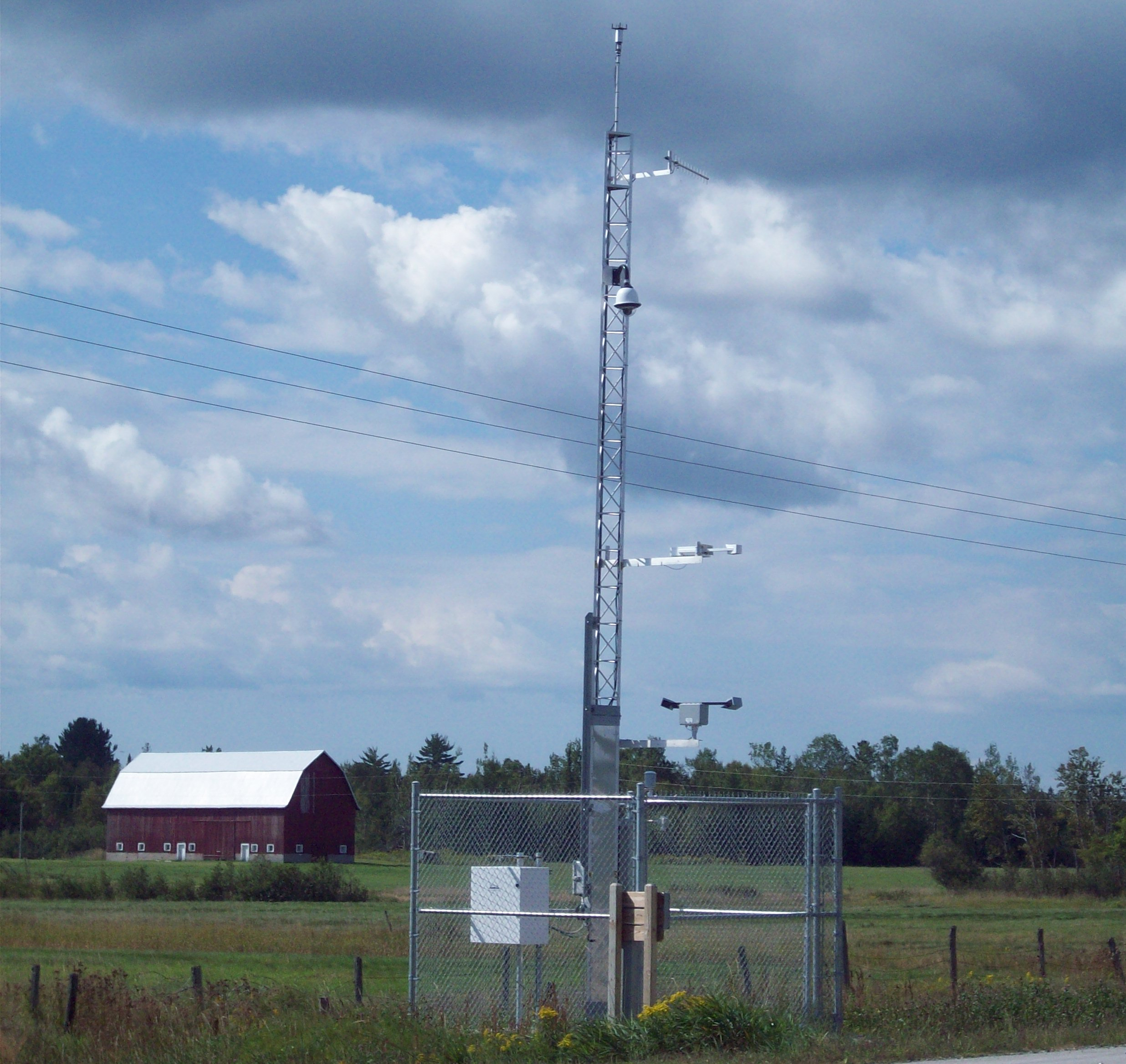
An environmental sensor station in the Upper Peninsula. Photo credit: MDOT.
By LAURA FOSMIRE
Capital News Service
LANSING — Upper Peninsula residents are getting help in navigating treacherous wintry roads thanks to federal stimulus money.
The Department of Transportation (MDOT) has installed 14 environmental sensor stations in key locations throughout the U.P.
“As part of our Recovery Act program, we put a broad-based plan in place that covered lots of different areas that the department works in,” said MDOT Director Kirk Steudle. “One of them in particular is intelligent transportation systems.”
Intelligent transportation systems include brightly lit billboards that alert motorists to delays and detours on major highways. They also include sensor stations, which gather information about weather patterns and road conditions.
“The station is basically a tower,” said Randy VanPortfliet, the U.P. regional engineer for MDOT. “They don’t look like much. They’re probably 30 or 40 feet high. Some have solar panels on them because we don’t have power in those locations.”
The stations gather meteorological data such as wind speed, temperature and air pressure, VanPortfliet said.
That information is transmitted to an office in Escanaba, where MDOT officials can deploy snowplows.
Steudle said, “Hopefully we’ll have maintenance vehicles in the right place at the right time, rather than just guessing where to send them and blanket-cover everything.”
VanPortfliet said the best part of the stations is that anyone can use the information, not just MDOT employees.
“Not only do we get to use them, but the public gets to use them too,” he said. “They can make decisions for themselves about whether or not to use snowy roads, or if they have to leave early because it looks so bad.”
The stations gather weather information and have cameras to show live feed of the roads. They can even measure the temperature of the pavement itself to determine the presence of black ice. The camera feed and the information are displayed online so the public can check road conditions.
VanPortfliet said that the stations are proving their worth.
“They’re already showing their effectiveness in helping us be prepared for a storm rather than reacting to a storm,” he said. “That’s the huge part. We can think ahead, rather than waiting until it hits and then figuring out what we have to do.”
The 14 stations are in frequent trouble spots for black ice, blowing snow and lake-effect snow.
“We made sure we had these stations by St. Ignace,” VanPortfliet said. “The road by Lake Michigan was closed four or five times a year, so we have three stations in that area so we can get our trucks ready and see what’s on the pavement.
“There are two of them over by the Munising and Marquette area,” he said. “There’s also one by Republic and one on the Seney Stretch. There’s one by Escanaba, Iron River and one south of Houghton, because that’s usually where lake-effect storms hit first.”
Steudle said intelligent transportation systems can also address problems other than weather, such as the condition of bridges in the U.P.
“Last year we put in new bridge and stress gauges,” he said. “We can tell what’s going on whenever vehicles drive over the bridge. There’s a weigh station in the pavement so we can get car weights, axle weights and speed even before they approach the bridge.”
An additional box on the stations collects that information and sends it wirelessly to MDOT bridge engineers in Lansing, who can keep an eye on bridge safety, Steudle said.
The project began two years ago with an original five stations funded by the federal government. With the additional stimulus money, MDOT was able to build the nine newest stations.
“We had been using federal highway dollars to build the stations before,” Steudle said. “The stimulus money accelerated that. If we didn’t have the stimulus funding, we still would have been building the stations, just at a slower rate.”
The $1.4 million for the project is a small percent of the total $800 million in stimulus money awarded to the state.
VanPortfliet said the cost of each station varies slightly because of the differences in soil conditions. Generally, each station costs around $50,000.
“We want to put more stations in downstate and 18 more in the U.P,” he said. “We’ll be searching for ways to fund that.”
VanPortfliet said that the additional stations are still in the “wish list” process, meaning that their future locations are subject to change.
He said that the stimulus money came with specific instructions on how it can be used.
“Even though we still have potholes and paving issues, money that comes from the federal government has to be spent on this type of work,” VanPortfliet said.
Steudle said that the MDOT plan can be used only on certain roads.
“Our plan just deals with U.S. routes,” he said. “They’re on the federal aid system. For county roads, it’s up to the counties if they want to put their money in this pot or another.”
VanPortfliet said the stations are having a positive impact on U.P. drivers.
“It really helps us by having that real-time information in 14 different locations,” he said. “The public can make decisions. And as their understanding gets more sophisticated, they can see if they might see ice today, or if it may turn to ice or freezing rain. You don’t want to get caught in that.”
Visit www.clarus-system.com to see live camera feed and weather information.
© 2010, Capital News Service, Michigan State University School of Journalism. Not to be reproduced without permission.
Story as a Google Doc